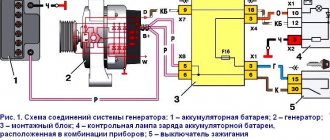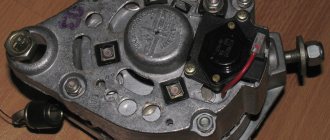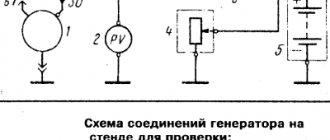A car generator is one of the key components of a car's electrical equipment; it is operated in harsh conditions and constantly experiences heavy loads. The generator developer takes full account of the features of its operation, paying attention to achieving high operational reliability. However, it is not possible to exclude failures of this node.
Diagnosis of electrical equipment at a service station during scheduled maintenance is included in the list of mandatory checks. Its implementation reveals emerging malfunctions and a high degree of wear of individual components, including the generator. However, even regular car maintenance in certified workshops is not a guarantee against sudden failures.
Next, we consider the procedures for checking the generator, which allow us to assess its technical condition with high accuracy using simple means. The peculiarity of this device is that the design of generators of different cars is based on identical principles, therefore the same testing methodology is used for them, which may differ only in minor details.
It is advisable to carry out work to check the serviceability of the generator using a large-block scheme and only after localizing the faulty unit proceed to accurate diagnostics. We will not dwell on the intricacies of identifying malfunctions of a specific component of this unit, which are carried out according to our own methods.
Signs of a faulty generator
External manifestations of generator failure include:
- the corresponding optical indicator on the dashboard remains active or flashes when the engine is running;
- extraneous noise;
- heating the case to too high a temperature;
- characteristic smell of burnt insulation;
- dim headlights, blinking light bulbs, unstable operation of other electricity consumers (primarily powerful ones), which is clearly manifested when the battery has exhausted its service life;
- battery discharge at a high rate.
During instrumental control, additional consideration is taken into account
- non-compliance of the generated voltage with the rated value, taking into account the existing tolerances in a wide range of loads;
- complete absence of tension.
What is what
The generator, or in popular transcription “gene”, pulls all the on-board electrical equipment, feeding it with electric current. Structurally, it is a conventional electric motor that works in reverse. The shaft here is rotated not by the EMF excited in the stator winding, but by a V-belt transmission connected to the crankshaft. As a result, the stator produces current. To ensure that the output voltage is little dependent on engine speed, a voltage regulator relay is built into the circuit.
It must be admitted that over the years this node becomes very problematic. The relay-regulator “gives up” first. However, the bearings on which the shaft with the belt pulley rotates can also jam. With mileage, the brushes of an electric machine wear out, and eventually the stator winding shorts out.
When that might happen is unknown. But, signs have long been studied that make it possible to notice the failure of the generator without waiting for the battery to drop to zero.
Checking the drive belt tension
Violation of the standard tension of the generator drive belt leads to the fact that when operating without load, the voltage corresponds to the norm, but when the load increases, insufficient friction force will lead to a slipping effect, the required power is no longer transmitted to the generator shaft, and the voltage drops. The load increases by sequentially switching on various consumers, for example, headlights.
If such a phenomenon is detected, we check the belt deflection, which, when pressed with a force of 10 kg, should not be more than 12 mm. If the belt is weakened, we restore its tension, which is done by using an adjusting screw that moves the generator stator away from the engine shaft.
Voltage Regulator Troubleshooting
Remove and disconnect the wires from the part. We inspect the condition of the brushes. They should not have significant defects or chips. In the guide channels of the brush holder, the generator brushes must move freely. If they protrude beyond the edge by less than 5 mm, the generator regulator should be changed.
The test is carried out using batteries and a 12-volt light bulb. The voltage of the second power source must be at least 15 V, so we connect the batteries in series to the car battery and adjust the value to the desired value. We attach the plus from the 1st power source to the output contact, and the minus to ground.
The light bulb is installed between the brushes. When connecting a 16 V source, it should not light up. With a weaker battery, it lights up. If proper combustion is not observed, the regulator should be replaced.
Basic checks without dismantling the generator
The procedures described below are carried out with a warmed-up engine, which runs at idle for 10 - 15 minutes. The primary check is based on the fact that the voltage removed from the generator exceeds the voltage of the battery (a necessary condition for recharging it). To do this, turn off the engine and measure the voltage at the battery terminals with a multimeter that is switched to constant voltage mode (limit 20 V or there). Then start the engine, perform a second measurement and compare the results. If there is no change, the generator is faulty.
The second group of tests is aimed at checking the relay regulator, for which they continue to monitor the output voltage of the generator with a multimeter. Its readings when the engine is running are 14 V. As the shaft speed increases, the voltage increases, but not more than 0.5 - 0.7 V. If this condition is violated, more detailed checks are carried out, the process of which is described here.
To check the generated current, the engine speed is increased to medium. Current clamps are connected to the multimeter, the device is switched to direct current measurement mode, and the working body of the clamps covers the wire from the output of the generator.
Next, sequentially turn on the electricity consumers (headlights, interior heater, etc.), record the readings of the device. Then the previously used consumers are turned on simultaneously and the multimeter readings are compared with the sum of the recorded values. The difference should not exceed 5A, otherwise the generator is considered faulty. The diode bridge is checked with a multimeter or by testing a light bulb for the absence of breakdown of the diodes and an open circuit in the current-carrying circuits. Diagnostics of the diode bridge is carried out on the engine or after dismantling the generator.
Explosive demarcation line, or Minefield between Donbass and Ukraine
Rostov region, January 16, 2022. DON24.RU. There are many puns and jokes with the word “shablya (saber)”, for example: the secretary was fired for not knowing the Ukrainian language - the word “shablya” was translated as “quiet, girls.” Our people love to laugh at themselves. What was the cost of the competition for the funniest surname, which was held by the radio station GalaRadio in 2010?
Residents of Kyiv were slightly shocked (to put it mildly) by the billboards: “Dyakuyu Choblya”, “Bearded Chornopiska”, “Is your lad Darmopuk?”, “Is your susid Shmarovoz?”. Self-irony is wonderful, but when the state gives reasons for laughter, and not for pride, it is sad.
From today in Ukraine, all advertising will be in Ukrainian, which means there will be a reason to laugh and cry at the creators of the new Ukrainian metology (mythology).
The company will hire a blyakhari
Today, every resident of Ukraine knows who Euroblachers are (drivers of foreign cars with Polish and Lithuanian license plates, which have proliferated since 2014), but this true story happened in 2005, when during the Orange Revolution the West defeated the East and creeping Ukrainization began. Films were dubbed into the state language, Soviet films were provided with subtitles, and television was required to broadcast in Ukrainian.
The owners of the cinemas cried out at first, but then reconciled: it was more profitable to work after losing some of the audience than to lose their license, and the dubbing was of quite high quality and, in general, did not interfere with the viewer’s enjoyment of art. The same cannot be said about the subtitles on the TV screen, which were terribly distracting, because the hastily made translation was replete with inaccuracies and watching films involuntarily turned into searching for and ridiculing mistakes.
Local television switched to language. It looked very tolerant: the announcers, program presenters and correspondents spoke the state language, and their interlocutors spoke their native language, Russian. The reason is that, despite the bilingualism of the residents of Donbass, the vast majority do not have birationality, that is, the ability to think in two languages. Therefore, the joke “I’m like a dog: I understand everything, but I can’t say it” was especially relevant when a microphone was brought to a person’s face.
At that time, the first attempt was made to translate print media into the state language, but failed miserably. Just like the Ukrainization of secondary and higher technical education. This is exactly what the story about the plaque is about. Blyakhar is a tinsmith, and, in principle, the etymology of the word can be traced (blyakh - metal sheet, tin).
In the Ukrainian language there are much more wonderful names of professions that drive not only the average person into a stupor, but also the all-knowing Google. For example, a sampler, a chiller-folder, an alundum, etc.
And the word “blakhar”, due to its consonance with the well-known swear word, then became a symbol of the failure of state policy in the field of advertising and the media, which are overwhelmingly private.
In practice, faced with translation difficulties, newspaper owners faced not only personnel, but also financial problems.
Firstly, imagine what hell the work of editors and proofreaders has become, forced to translate advertisements and notices into Ukrainian, because citizens selling cars, equipment, building materials, etc., stubbornly wrote in Russian or in a terrifying mixture of two languages, which only slowed down the translation process.
The proofreaders did not have Google to help them, because there was no computer - they read proofs. Secondly, what came out in the end did not suit the consumer of the service at all, that is, the reader of the newspaper. All these terms: lantsyug, galma, rozpodilnik zapalyuvannya, gorge perelizhka and other tsegla - together made the text unreadable.
Thirdly, the owners of the media did not want to hire additional translators, and universities did not train them. Just like teachers who are capable of teaching physics and chemistry (not to mention strength of materials) in Ukrainian. In general, the blyakhar as a phenomenon was at first amusing, but in the end it threatened to collapse. I don’t know who the media owners were bowing to or insulting, but in 2005 the law regarding advertising was quickly repealed or allowed to be ignored.
Citizens were given three years
15 years have passed. If you want to buy or sell something on the Internet and go to the corresponding Ukrainian resources, you will see that little has changed over the years. It’s easy to check my words: type the word “auto parts” into a search engine and draw the conclusion: regardless of the region, the lion’s share of ads are in Russian.
Meanwhile, on January 16, 2022, the norm of the law “On ensuring the functioning of the Ukrainian language as the state language” regarding the language of advertising comes into force in Ukraine. It states that advertising must be in Ukrainian on TV and radio, external media, on the Internet, including social networks. This is the same law that presidential candidate Vladimir Zelensky promised to review, and then forgot. Or he was told to forget.
This is the same law about which many copies were broken, but Poroshenko still signed it. Just before leaving. And back in 2018, media owners raised the question of the collapse of newspapers and magazines due to the unprofitability of Ukrainian circulation.
“It is impossible to bear such losses every month. And as a result, even that part of the population that still reads printed publications today will be deprived of this opportunity, since publishing houses will simply go bankrupt without state support,” said Olga Guk-Dremina, editor of the Segodnya newspaper.
I think the media moguls finally managed to finance the Ukrainian versions. And Ukrainian citizens were given three years to master technical terms. If the law is not complied with, in 2023 you will have to pay 200–300 non-taxable minimums - from 3400 to 5100 UAH. If this happens again, the amount will double.
What advice can I give to grown-ups who don’t know how to use a “gearbox” in a sovereign language? Address children. This academic year there are only 11 first grades left in the Lugansk region. In 306 classes, first-graders will receive education in Ukrainian.
Battery overcharge
However, often it is not “undercharging” and “overcharging”. The electrolyte from the battery boils away and the battery also fails; there is nothing good about this either.
The first sign will be white streaks on the top of the battery, which means the electrolyte simply boils and evaporates. That is, the battery is charged, but the generator still “craps” charging it. The relay regulator has most likely failed here.
The check here is also elementary - you need to connect a multimeter or tester (whatever they call it) with the car running, and look at the charge. If it greatly exceeds 14.5 - 14.8 V, but is within the range of 15 - 15.2 V, it means that it is overcharging. We urgently change the relay-regulator, otherwise you will constantly boil your battery, ALSO NOTHING GOOD. It’s trivial that the plates may crumble.
Now let's watch the video version.
That’s all, he told me, exactly the methods without removing it from the car, and of course give it to a good auto electrician for repairs.
This is where I end, sincerely yours, AUTOBLOGGER.
Similar news
- Why does the alternator belt whistle? When cold or under load. ...
- Generator overrunning clutch. What is it and what is it for? Important...
- Engine chip tuning. Advantages and disadvantages. Is it worth doing at all? ...
Add a comment Cancel reply
How to check the stator
The performance of the generator stator can be checked in two ways: visually - for the presence of workings, and also using the same multimeter.
To do this, you need to connect the windings of the part to the wires of the device.
The measurement is carried out in Ohms without connecting to a diode bridge. In normal condition, the arrow should show a resistance of 0.2 Ohm.
The correct value between zero and stator positive is 0.3 Ohm.
The malfunction of this part is signaled by the generator itself during operation: it emits an increased hum.
Diode bridge
The diode bridge consists of six separate diodes: half of them are positive, the other half are negative. It is necessary to select the “Dial” mode on the multimeter. After this, as soon as the contacts on the tester close, a soft beeping sound will be heard. You need to check in both directions. If a squeak is heard in both cases, then this indicates a breakdown of the diode. Therefore, it needs to be replaced.
We call the diode bridge
When the multimeter probes are positioned as in the following photos, the resistance should be infinite, if the probes are swapped - within 700 Ohms.
Procedure for checking negative diodes
Checking the positive diodes
Now the auxiliary diodes
Pullers for standard parts
It is enough to simply knock the front bearing out of the cover with a hammer, even if there is a flange, so in 99% of cases only a puller for the rear bearings of the generator of two types is used:
- with two legs;
- with three legs;
Moreover, the device can be made independently; the most popular are two designs:
- the lower part of the split bushing is put on the outer race of the bearing, a bolt passes through the upper part, the halves of the bushing are pulled together by a tubular casing, a cover made of thick-walled metal is put on the bolt under the nut;
- in a square pipe, cuts are made from below, into which, after being placed on the outer race of the bearing, steel plates are inserted; a nut is welded to the top of the pipe, into which a bolt of sufficient length is screwed.
With homemade devices, replacing a generator bearing is both faster and cheaper. However, they will take some time to produce.
What components and parts are checked using a multimeter?
This operation involves diagnosing the electrical part, and checking the following parts:
Voltage measurements are taken at the generator output;- the rotor excitation winding is checked for open circuit or short circuit to the housing;
- checking the stator windings for breakdown and open circuit;
- carry out fault detection of the diode bridge, capacitor;
- faults in the voltage regulator and brushes are detected;
Performing each of the listed operations requires special knowledge and skill to carry out measurements, so each test should be considered in more detail.
What can't you do?
Before you check the generator, you need to know what you should never do during diagnostics:
Generator unit design
Bearing sizes and manufacturers
Before replacing a bearing with a new standard product, you need to buy it. The marking of these standard consumables is complex; the numbers in it are deciphered using special tables. Moreover, bearing designations according to GOST 3189 do not coincide with the markings of foreign manufacturers, so the user needs to know the following nuances:
- the marking consists of three parts (main, left, right), and blocks inside them;
- in the left and main parts the blocks are located from right to left, and in the right block on the contrary, from left to right;
- in cars, the front bearing of the generator most often has the designation of the main part 302 or 303, and the rear bearing 202 or 203;
- usually radial ball modifications with code 0 (0302 or 0202) or angular contact balls with code 6 (6303 and 6203) are used;
- therefore, for the specified parameters, you can decipher the dimensions using the table below;
- For foreign-made bearings, similar markings are used.











